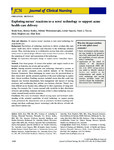Exploring nurses’ reactions to a novel technology to support acute health care delivery
| dc.contributor.author | Kent, B | |
| dc.contributor.author | Redley, B | |
| dc.contributor.author | Wickramasinghe, N | |
| dc.contributor.author | Nguyen, L | |
| dc.contributor.author | Taylor, NJ | |
| dc.contributor.author | Moghimi, H | |
| dc.contributor.author | Botti, M | |
| dc.date.accessioned | 2016-12-16T18:34:10Z | |
| dc.date.available | 2016-12-16T18:34:10Z | |
| dc.date.issued | 2015-08 | |
| dc.identifier.issn | 0962-1067 | |
| dc.identifier.issn | 1365-2702 | |
| dc.identifier.uri | http://hdl.handle.net/10026.1/8141 | |
| dc.description.abstract |
<jats:sec><jats:title>Aims and objectives</jats:title><jats:p>To explore nurses’ reactions to new novel technology for acute health care.</jats:p></jats:sec><jats:sec><jats:title>Background</jats:title><jats:p>Past failures of technology developers to deliver products that meet nurses’ needs have led to resistance and reluctance in the technology adoption process. Thus, involving nurses in a collaborative process from early conceptualisation serves to inform design reflective upon current clinical practice, facilitating the cementing of ‘vision’ and expectations of the technology.</jats:p></jats:sec><jats:sec><jats:title>Design</jats:title><jats:p>An exploratory descriptive design to capture nurses’ immediate impressions.</jats:p></jats:sec><jats:sec><jats:title>Methods</jats:title><jats:p>Four focus groups (52 nurses from medical and surgical wards at two hospitals in Australia; one private and one public).</jats:p></jats:sec><jats:sec><jats:title>Results</jats:title><jats:p>Nursing reactions towards the new technology illustrated a variance in barrier and enabler comments across multiple domains of the Theoretical Domains Framework. Most challenging for nurses were the perceived threat to their clinical skill, and the potential capability of the novel technology to capture their clinical workflow. Enabling reactions included visions that this could help integrate care between departments; help management and support of nursing processes; and coordinating their patients care between clinicians. Nurses’ reactions differed across hospital sites, influenced by their experiences of using technology. For example, Site 1 nurses reported wide variability in their distribution of barrier and enabling comments and nurses at Site 2, where technology was prevalent, reported mostly positive responses.</jats:p></jats:sec><jats:sec><jats:title>Conclusion</jats:title><jats:p>This early involvement offered nursing input and facilitated understanding of the potential capabilities of novel technology to support nursing work, particularly the characteristics seen as potentially beneficial (enabling technology) and those conflicting (barrier technology) with the delivery of both safe and effective patient care.</jats:p></jats:sec><jats:sec><jats:title>Relevance to clinical practice</jats:title><jats:p>Collaborative involvement of nurses from the early conceptualisation of technology development brings benefits that increase the likelihood of successful use of a tool intended to support the delivery of safe and efficient patient care.</jats:p></jats:sec> | |
| dc.format.extent | 2340-2351 | |
| dc.format.medium | Print-Electronic | |
| dc.language | en | |
| dc.language.iso | eng | |
| dc.publisher | Wiley | |
| dc.subject | acute care | |
| dc.subject | design science | |
| dc.subject | information systems | |
| dc.subject | nurses' reactions | |
| dc.subject | nursing informatics | |
| dc.title | Exploring nurses’ reactions to a novel technology to support acute health care delivery | |
| dc.type | journal-article | |
| dc.type | Journal Article | |
| dc.type | Research Support, Non-U.S. Gov't | |
| plymouth.author-url | https://www.webofscience.com/api/gateway?GWVersion=2&SrcApp=PARTNER_APP&SrcAuth=LinksAMR&KeyUT=WOS:000359259100030&DestLinkType=FullRecord&DestApp=ALL_WOS&UsrCustomerID=11bb513d99f797142bcfeffcc58ea008 | |
| plymouth.issue | 15-16 | |
| plymouth.volume | 24 | |
| plymouth.publication-status | Published | |
| plymouth.journal | Journal of Clinical Nursing | |
| dc.identifier.doi | 10.1111/jocn.12881 | |
| plymouth.organisational-group | /Plymouth | |
| plymouth.organisational-group | /Plymouth/Faculty of Health | |
| plymouth.organisational-group | /Plymouth/Faculty of Health/School of Nursing and Midwifery | |
| plymouth.organisational-group | /Plymouth/REF 2021 Researchers by UoA | |
| plymouth.organisational-group | /Plymouth/REF 2021 Researchers by UoA/UoA03 Allied Health Professions, Dentistry, Nursing and Pharmacy | |
| plymouth.organisational-group | /Plymouth/Research Groups | |
| plymouth.organisational-group | /Plymouth/Research Groups/Institute of Health and Community | |
| plymouth.organisational-group | /Plymouth/Research Groups/Plymouth Institute of Health and Care Research (PIHR) | |
| plymouth.organisational-group | /Plymouth/Users by role | |
| plymouth.organisational-group | /Plymouth/Users by role/Academics | |
| dc.publisher.place | England | |
| dcterms.dateAccepted | 2015-04-16 | |
| dc.identifier.eissn | 1365-2702 | |
| dc.rights.embargoperiod | 12 months | |
| rioxxterms.versionofrecord | 10.1111/jocn.12881 | |
| rioxxterms.licenseref.uri | http://www.rioxx.net/licenses/under-embargo-all-rights-reserved | |
| rioxxterms.licenseref.startdate | 2015-08 | |
| rioxxterms.type | Journal Article/Review |


